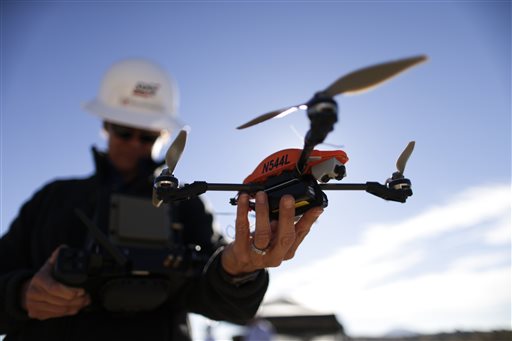
In this Oct. 16, 2014, file photo, former Navy helicopter pilot and San Diego Gas & Electric unmanned aircraft operator Teena Deering holds a drone as it is prepared for takeoff near Boulevard, California. Long-awaited rules to usher in a new era in which small, commercial drones zipping through US skies are a part of everyday life were proposed by the Federal Aviation Administration on Sunday, Feb. 15, 2015. AP FILE PHOTO
Washington–US aviation regulators unveiled sweeping new guidelines Sunday governing the use of small unmanned drones, proposing that the devices can only fly in daylight, must remain within users’ sightlines and cannot fly near manned aircraft.
The guidelines from the Federal Aviation Administration (FAA) also recommend that drone operators obtain a special certificate to be renewed every two years and limits the speed of the drone to 100 miles (161 kilometers per hour). Users would have to be 17 years or older.
The devices would also be required to fly below 500 feet (150 meters) in altitude and would not be permitted near airports or other airspace without special permission.
The new guidelines would apply to drones, or unmanned aircraft systems, that are under 55 pounds (25 kilograms.)
The recreational use of drones has soared in popularity recently, but their use in the United States has remained largely unregulated.
President Barack Obama has called for more stringent rules on drone use after a “quadcopter” device crashed on White House grounds last month, prompting a security alert.
The FAA said the new rules sought to balance innovation with safety, and the agency’s administrator Michael Huerta called the proposed guidelines a milestone.
“We have tried to be flexible in writing these rules,” he said.
“We want to maintain today’s outstanding level of aviation safety without placing an undue regulatory burden on an emerging industry.”
The public now has 60 days to make comments on the rules, which the FAA said it will consider before drafting a final proposal.
Privacy concerns
Also Sunday, the White House released a drones directive that sought to protect the privacy of citizens, prohibiting the illegal collection and dissemination of data by the devices.
A central pillar of the presidential memorandum is to ensure “the responsible use of this technology, strengthening privacy safeguards and ensuring full protection of civil liberties,” according to a White House statement.
Sharing or collecting information that would “discriminate against persons based upon their ethnicity, race, gender, national origin, religion, sexual orientation, or gender identity, in violation of law” would also be prohibited.
The White House said any new laws around drone use should ensure “protections and policies keep pace with developments.”
The US Center for Democracy and Technology welcomed the White House move, but warned drones “pose new and intrusive privacy problems” and urged lawmakers to do more to protect civil liberties.
“Congress still has a role to play in setting strong privacy and transparency standards for drone use,” the agency’s senior counsel Harley Geiger said.
Commercial use
The latest proposal from the FAA does not include the use of drones by delivery companies, such as Amazon, which has said it wants to use drones to deliver goods to customers.
Huerta said the agency was conducting separate research regarding drone use for those purposes.
“We have ongoing activities to address the questions of beyond visual line-of-site and we do want to receive comments from people with respect to how we should structure this going forward,” he said in a conference call Sunday.
“We also don’t consider and don’t contemplate in this a rule carrying packages outside of the aircraft itself,” he said, regarding using drones for delivery purposes.
The FAA said unmanned aircraft could be used for a variety of activities, including inspecting utility towers, antennas, bridges, power lines and pipelines; conducting academic research; supporting wildlife conservation; monitoring crops; and in search and rescue operations.
Several media organizations have also expressed interest in using drones to film and photograph aerial images.
Huerta said while drone use in these areas was valuable, the devices could also pose security risks if unregulated.
“We envision that this aircraft could be used for a wide variety of activities particularly those that might be considered dangerous,” Huerta said.
The FAA has been testing drone use at six sites across the country since late 2013.
Various US federal agencies regularly use drones, including to monitor wildfires, conduct scientific research, monitor borders and in military training.